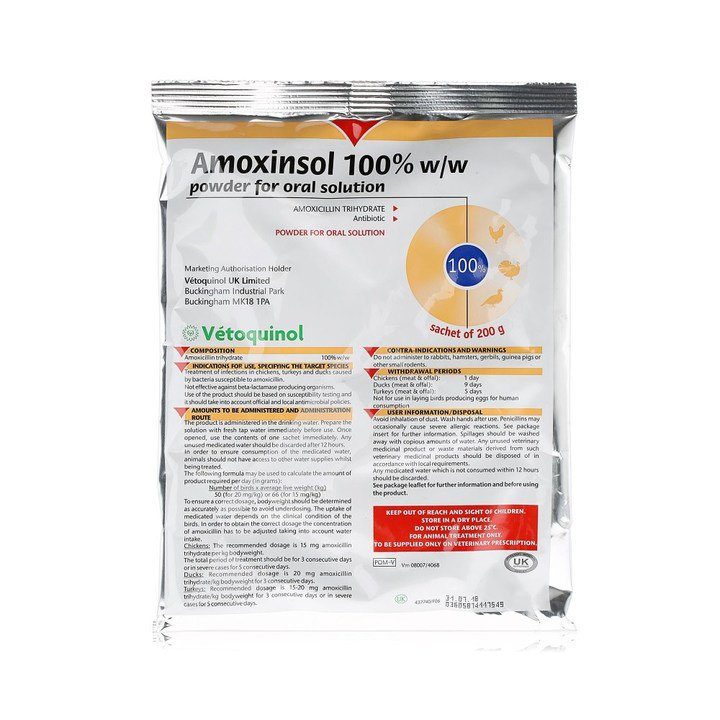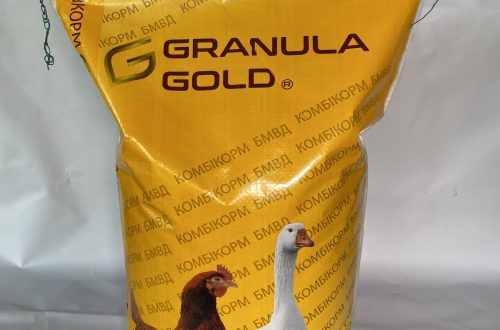
Antibiotics used to treat chickens and chickens – dosage, recommendations for use
Breeding and raising chickens today is a very profitable occupation, since as a result of this activity you can get not only tasty, dietary meat, but also fluff and eggs.
From the first days, as soon as chickens appeared in your farmstead, you should provide them with all the necessary vitamins and microelements.
Many owners of small private households immediately begin to use antibiotics, hoping to prevent the occurrence of various diseases. In no case should this be done, since a newly hatched chicken practically does not have its own microflora (pathogenic or non-pathogenic) and while it is developing, the chick needs to develop immunity, and the use of antibiotics during this period can lead to disruption of the gastrointestinal tractand, as a result, disease.
Therefore, initially chickens must be provided with proper nutrition and vitamins. And only after the birds have received a complex of vitamins, one should start taking antibiotics in order to prevent various infectious diseases.
After giving the chickens a course of antibiotics, a short break (7 days), after which vitamins are given again, then a break (3 days)and more antibiotics. This cycle is repeated constantly, the entire period of growing broilers and laying hens.
Contents
Vaccination
Owners of private farmsteads today very rarely use this method of preventing and treating infectious diseases of chickens, believing that it is too complicated. In fact, there is nothing easier, because most vaccines are drunk with water or added to feed, you only need to know the frequency of use and dosage of the drug. If possible, it is better to take a scheme for the use of antibiotics at the poultry farm where you purchased young or already adult chickens.
Diseases of chickens and their treatment
Salmonellosis (paratyphoid)
One of the most common and dangerous diseases for both chickens and adult chickens. Caused by a bacterium salmonella, which provokes damage to the organs of the gastrointestinal tract. According to statistics, chickens are most susceptible to this disease.
Symptoms:
- heat;
- weakness;
- lethargic, depressed behavior;
- lack of mobility;
- rapid breathing with wheezing;
- partial or complete paralysis of the wings and legs, inflamed joints;
- yellowed mucous, foamy discharge from the beak and nose;
- swollen, watery eyelids;
- intense thirst, accompanied by a complete lack of appetite;
- diarrhea.
Antibiotic treatment. One of the most effective drugs is chloramphenicol.. It should be used 3 times a day at the rate of 30–50 mg/kg. live body weight. This antibiotic is also used in the treatment of colibacillosis, leptospirosis, colienteritis and other infectious diseases of chickens and chickens. Also, a drug such as disparcol has proven itself well.. The course of salmonellosis is very fast and even injections can not always help (there is simply not enough time), so it is better to prevent the disease by taking preventive measures at the earliest age of the chickens.
Coccidiosis (bloody diarrhea)
The disease is caused by small parasites called conidia.. It affects the kidneys, intestines, sometimes the liver. In the first weeks of life (up to 2,5–3 months of age), young chickens are especially susceptible to this disease, since an adult bird has already developed immunity.
Symptoms:
- lack of appetite;
- diarrhea, stools at first have a greenish tint, turning into brown with drops of blood;
- depression, depression, apathy, chickens do not want to leave the perch;
- disheveled dirty feathers, lowered wings, unsteady gait.
Sick individuals should be immediately isolated from the rest and treatment should begin. Treatment is with medications such as sulfadimezin, zolen, coccidine, furazolidone. The antibiotic is mixed with water or added to the feed.
Pullorosis (typhoid)
Both chickens and adults are susceptible to this disease. The disease is transmitted by airborne droplets, causing damage to the organs of the gastrointestinal tract.
Symptoms:
- in an adult chicken, the comb and earrings are pale;
- lack of appetite, accompanied by diarrhea and intense thirst;
- liquid stools, at first white, then yellowish;
- shortness of breath; chickens weaken, fall on their legs or roll over on their backs;
- chickens are severely malnourished.
Treatment. At the first sign of illness, chickens should be isolated and given antibiotics. Biomycin or biomycin is used. In addition to the drug, furazolidone should be added to the feed of not only sick birds, but also healthy ones.
Pasteurellosis (fowl cholera)
It affects all types of wild and domestic birds.
Symptoms:
- heat;
- lethargy, inactivity, depression;
- intense thirst with a complete lack of appetite;
- indigestion, liquid greenish stool, sometimes with drops of blood;
- mucus is secreted from the nose;
- hoarse, difficult breathing;
- bluish comb and earrings;
- the joints on the legs are crooked and swollen.
Antibiotics of the sulfa group are used for treatment. Sulfamethazine is added to water at the rate of 1 g/l. On the first day, 0.5 g / l – in the next 3 days.
Marek’s disease (neurolymphomatosis)
Other name – infectious paralysis is caused by a virus that infects the nervous system, eyes. Painful tumors form on the skin, skeleton and internal organs. In sick chickens, there is a strong violation of all motor functions.
Symptoms:
- general exhaustion of the body, loss of appetite;
- the pupil narrows, possibly the onset of complete blindness;
- the iris of the eyes changes;
- earrings, scallop, mucous membranes have a pale, almost colorless appearance;
- goiter paralysis occurs;
- due to weakened motor functions, chickens do not move well.
Treatment. There is no cure for Marek’s disease.. The bird must be destroyed as soon as possible.
infectious bronchitis
In chickens, the respiratory organs are affected, in an adult bird, reproduction is disturbed. Egg production decreases, up to a complete cessation.
Symptoms:
- shortness of breath, cough;
- mucus flows from the nose, rhinitis;
- sometimes there is conjunctivitis;
- chickens freeze, appetite disappears;
- growth and development slows down;
- in an adult bird, egg production decreases;
- there is damage to the kidneys and ureters, accompanied by diarrhea.
Treatment of infectious bronchitis in chickens is not treatable.
Colibacillosis
All types of poultry are susceptible to the disease. The disease is caused by a pathogenic Escherichia coli that affects most of the internal organs.
Symptoms:
- lack of appetite with severe thirst;
- lethargy;
- temperature increase;
- hoarse, difficult breathing;
- in some cases – a disorder of the digestive system.
Treatment is with antibiotics: biomycin or terramycin. The drug is mixed with feed at the rate of 100 mg/kg. In addition to it, sulfadimezin and multivitamins are used.
Mycoplasmosis
Respiratory disease. Appears in chickens of all age groups.
Symptoms:
- inflamed, reddened eyes;
- secretion of mucus and fluid from the nose;
- difficult, hoarse breathing, which is accompanied by coughing and sneezing;
- sometimes there is a disorder of the gastrointestinal tract.
Treatment. Within 7 days, antibiotics are added to the feed (oxytetracycline or chlorine tetracycline) in the calculation of 0,4 g / kg. Then, after a 3-day break, the course is repeated. You can also use other antibiotics: erythromycin, chloramphenicol, streptomycin, etc.
chickenpox
In a diseased chicken, characteristic pockmarks appear on the skin, and white discharge appears in the oral cavity. The chickenpox virus infects the cornea of the eyes and internal organs.
Symptoms:
- red spots appear on the skin, characteristic scabs;
- the air exhaled by the bird has an unpleasant odor;
- swallowing difficult;
- there is an exhaustion of the body, weakness.
Treatment is effective only at the beginning of the disease. The affected areas of the skin are treated with a 2% solution of boric acid or furacilin (3-5%). Inside give antibiotics: terramycin, tetracycline or biomycin. The course of treatment is 7 days.
Newcastle disease
The virus is transmitted by airborne droplets. The disease is more common in young individuals.
Symptoms:
- drowsiness;
- heat;
- mucus accumulates in the nose and mouth;
- the bird makes circular movements, twitches its head;
- coordination of movements is broken;
- the color of the scallop is cyanotic;
- swallowing reflex is absent.
Not amenable to treatment. The death of a bird is 100%. The disease is a danger to humans.
Bird flu
The disease has an acute viral form, affects the respiratory and gastrointestinal tract.
Symptoms:
- breathing is hoarse, labored;
- diarrhea;
- elevated temperature;
- bluish color of comb and earrings;
- lethargy, drowsiness.
Not amenable to treatment.
Infectious bursal disease (Gumboro disease)
Chickens up to 4 months of age get sick. The virus causes inflammation of the bursa of Fabricius and the lymphatic system, hemorrhage is observed in the stomach and muscle tissues. The immunity of chickens is reduced, which can lead to an increase in mortality. Signs of the disease are not expressed. Body temperature is normal or slightly low, diarrhea. Not amenable to treatment.
Laryngotracheitis
The disease proceeds in an acute form, expressed in irritation and inflammation of the mucous membrane on the surface of the trachea and larynx.
Symptoms:
- breathing is difficult, wheezing;
- conjunctivitis;
- reduced egg production.
Treatment will be most effective only at the beginning of the disease. Can use tromexin, which facilitates the course of the disease. The drug is given as a solution: the first day – 2 g / l, the next – 1 g / l. The course of treatment is 3-5 days.
When using antibiotics for the treatment and prevention of infectious diseases of chickens, you should carefully read the attached instructions and in no case engage in amateur activities. Treatment with the drug should take place as a whole course, which is combined with the simultaneous intake of vitamins. Using antibiotics in the treatment of poultry, it must be remembered that excessive enthusiasm for them can have a completely opposite effect, that is, in the event of an overdose, a sick bird may die instead of recovering.





